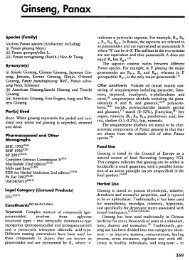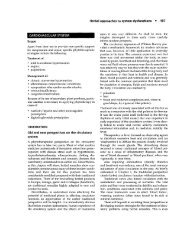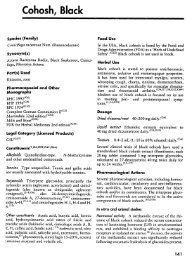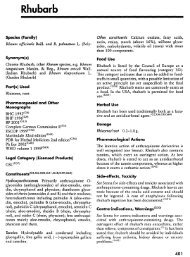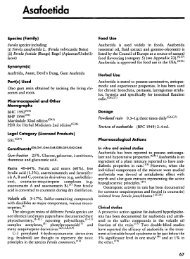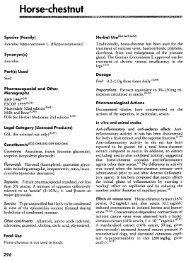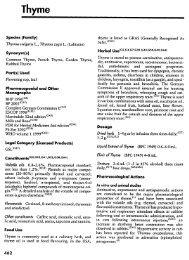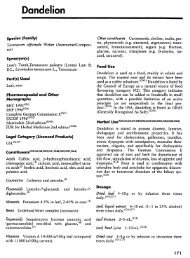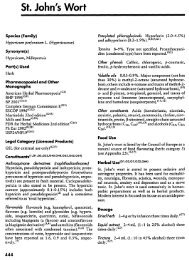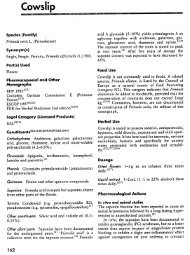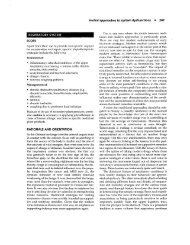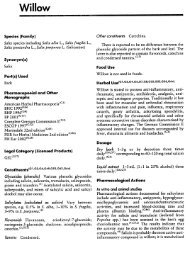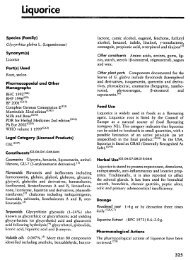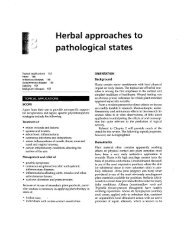Cascara
Cascara
Cascara
Create successful ePaper yourself
Turn your PDF publications into a flip-book with our unique Google optimized e-Paper software.
Species (Family)<br />
Rhamnus purshiana DC . (Frangula purshiana (DC) .<br />
A . Gray ex J .C. Cooper) (Rhamnaceae)<br />
Synonym(s)<br />
<strong>Cascara</strong> Sagrada, Rhamni Purshianae Cortex,<br />
Rhamnus<br />
Part(s) Used<br />
Bark<br />
Pharmacopoeial and Other<br />
Monographs<br />
BHP 1996 (G9)<br />
BP 2001 (G15)<br />
Complete German Commission E(G3)<br />
ESCOP 1997 (G52)<br />
Martindale 32nd edition (G43)<br />
PDR for Herbal Medicines 2nd edition (G36)<br />
Ph Eur 2002 (G28)<br />
USP24/NF19 (G61)<br />
Legal Category (Licensed Products)<br />
GSL (G37)<br />
Consfituents (G2,G6,G41,G48,G52,G59,G62,G64)<br />
Anthrocene glycosides Pharmacopoeial standard,<br />
not less than 8 % hydroxyanthracene glycosides<br />
. (G15,G28) Cascarosides A and B are anthrone<br />
C- and O-glycosides being 8-O-R-D-glucosides of<br />
10-S-deoxyglucosyl aloe-emodin anthrone (aloin A)<br />
and of 10-R-deoxyglucosyl aloe-emodin anthrone<br />
(aloin B), respectively. Cascarosides C and D are<br />
the 8-0-(3-D-glucosides of 10-(R)-(S)-deoxyglucosyl<br />
chrysophanol anthrone (chrysaloin A and B, respectively)<br />
. Cascarosides E and F are the 8-0- 3-D-glucosides<br />
of 10-deoxyglucosyl emodin-9-anthrone. The<br />
cascarosides comprise 60-70% of the total hydroxyanthracene<br />
complex. Aloins A and B, chrysaloins A<br />
and B account for 10-30% of the total hydroxyanthracene<br />
complex . The remaining 10-20% is a<br />
mixture of hydroxyanthracene 0-glycosides including<br />
monoglucosides of aloe-emodin, chrysophanol,<br />
emodin and physcion.<br />
110<br />
<strong>Cascara</strong><br />
Other constituents Linoleic acid, myristic acid,<br />
syringic acid, lipids, resin and tannin .<br />
Food Use<br />
<strong>Cascara</strong> is listed by the Council of Europe as a natural<br />
source of food flavouring (category N4) . This<br />
category indicates that while the use of cascara for<br />
flavouring purposes is recognised, it cannot be classified<br />
into the categories N1, N2 or N3 because of<br />
insufficient information . (G16) In the USA, cascara has<br />
been approved for food use . (G41)<br />
Herbal Use (G2,G4,G6,G8,G43,G52,G54,G64)<br />
<strong>Cascara</strong> is stated to possess mild purgative properties<br />
and has been used for constipation . The German<br />
Commission E approved for use for treatment of<br />
constipation . (G3)<br />
Dosage<br />
Dried bark 0 .3-1 g single daily dose . (W)<br />
Infusion 1 .5-2 g in 150 mL water . (G3)<br />
<strong>Cascara</strong> Liquid Extract (BP 1980) 2-5 mL .<br />
Preparations Equivalent to 20-30 mg hydroxyanthracene<br />
derivatives calculated as cascaroside A,<br />
daily . (G3)<br />
Pharmacological Actions<br />
The laxative action of anthraquinone glycosides is<br />
well recognised (see Senna) . <strong>Cascara</strong> has a laxative<br />
action. (G45)<br />
Clinical studies<br />
Studies involving elderly patients suggest that cascara<br />
treatment, compared with placebo, leads to relief of<br />
constipation and increased bowel movements . (l)<br />
Side-effects, Toxicity<br />
The side-effects and toxicity documented for anthraquinone<br />
glycosides are applicable (see Senna) . (G22)
Contra-indications, Warnings<br />
<strong>Cascara</strong> is contra-indicated for patients with intestinal<br />
obstruction, acute intestinal inflammation, e .g .<br />
Crohn's disease, colitis, appendicitis, abdominal pain<br />
of unknown origin, and in children under 12 . IG3)<br />
<strong>Cascara</strong> should not be used over an extended period<br />
of time . (G3)<br />
Pregnancy and lactation <strong>Cascara</strong> should not be used<br />
during pregnancy and lactation .<br />
Pharmaceutical Comment<br />
The chemistry of cascara is characterised by the<br />
anthraquinone derivatives, especially the cascarosides<br />
. The laxative action of these compounds is<br />
well recognised. <strong>Cascara</strong> has been used extensively<br />
in conventional pharmaceutical preparations .<br />
<strong>Cascara</strong> ill<br />
Stimulant laxatives have largely been superseded<br />
by bulk-forming laxatives. However, the use of<br />
non-standardised anthraquinone-containing preparations<br />
should be avoided since their pharmacological<br />
effects will be variable and unpredictable .<br />
In particular, the use of products containing<br />
combinations of anthraquinone laxatives is not<br />
advisable .<br />
References<br />
See also General References G2, G3, G6, G9, G12,<br />
G15, G16, G18, G20, G22, G28, G29, G31, G36,<br />
G37, G41, G43, G48, G54, G61, G62 and G64 .<br />
1 Petticrew M et a!. Epidemiology of constipation<br />
in the general adult population . Health Technol<br />
Assess 1997 ; 1 : 1-52 .



